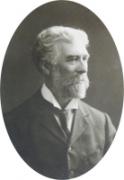|
|
||||||||||||||||||||||||
 |
Featured person
Recently added |
John Murphy Farley (or Farrelly) (1842 - 1918): |
||||||||||||||||||||||

|
Cardinal John Murphy Farley rose to become for sixteen years Archbishop of New York, one of the leading, and largest, dioceses in the entire Catholic Church, presiding over its expansion in membership, clergy, church building and education at all levels.
John Farley was born in Newtownhamilton, County Armagh on 20 April 1842, the son of Philip Farrelly (sic), a well-off farmer, native of Carnalynch near Bailieboro, a major town of County Cavan; and Catherine Murphy, a native of the townland of Moyles near Monaghan town. Farley changed the spelling of his surname in 1872.
Orphaned in 1854 at the age of twelve, he then went to live with his mother’s family in Moyles, near Monaghan Town. Educated firstly at the local National School, then at St Macartan’s College, Monaghan, he emigrated to the United States in 1864, and studied at St John’s College, Fordham, New York and St Joseph’s Seminary, Troy, New York. He moved to Rome in 1867 where he completed his studies at the American College. He was ordained there on 11 June, 1870 by Cardinal Patrizi. It was in Rome that he met his future Bishop and patron, in the autumn of 1869: Archbishop McCloskey was there attending the historic First Vatican Council.
Back in the US, Father Farley’s first ministry in the New York diocese was as a curate in St Peter’s, Staten Island in 1870. In 1872 he was appointed Secretary to Archbishop McCloskey and served in that position until 1884 when he was awarded the title of Monsignor and appointed pastor at St Gabriel’s, East 37 Street. In 1891 he was appointed Victor-General of the archdiocese by Archbishop Corrigan; a domestic prelate in 1892 and on 21 November 1895 was consecrated titular Bishop of Zeugma and Auxiliary Bishop of New York, the first to hold the post.
Monsignor John Murphy Farley was elevated to the position of Archbishop of New York on 15 September 1902. His demise in 1918 ended an episcopate of 16 years. During this time the actual number of members of the parish grew from 1,200,000 to 1,325,000, though for other numbers expansion was more striking: for churches, 276 to 388; for priests, 716-1117; for parish schools, 96-188. For tertiary level education, some thought he was more cautious, as when he rather acted against St Joseph’s Seminary, the major such in the archdiocese, which was frowned upon by some opposed to the fairly new Modernism. Pope Pius X had promulgated an Encyclical in 1907, Pascendi Dominici Gregis, which spoke in fairly strong terms against those, clerical and lay, who “not sparing even the Person of the Divine Redeemer, whom, with sacrilegious audacity, they degrade to the condition of a simple and ordinary man.” Farley obtained the resignation of the Rector of the Seminary and the suppression of its journal, the New York Review.
However, in 1908 came the centenary of the archdiocese which was enthusiastically celebrated, underlining the central role of the Irish population of the city; Michael, Cardinal Logue, Archbishop of Armagh and Primate of All Ireland, crossed the Atlantic to be present at the proceedings.
Farley was raised to the Sacred College of Cardinals on 28 October 1911.
Cardinal Farley visited his Newtownhamilton birthplace on three occasions; He dedicated two stained glass windows to the memory of his parents, one in St Patrick's Cathedral, Armagh city and the other in St Patrick's Church, Cullyhanna, County Armagh.
Farley authored some works on Church history, including on St Patrick’s Cathedral, and also a Life of John, Cardinal McCloskey, First Prince of the Church in America, 1810-1885 (publ. 1918; Farley had been his Secretary). He was remembered very positively especially by those with whom he worked; he was a genial person and as Archbishop was seen as a conciliator – as in almost any large organisation ecclesial or otherwise, there were factional tendencies in the Archdiocese – and an efficient administrator, with an all-embracing knowledge of the Archdiocese.
He died in New York on 17 September 1918 and was interred in the crypt of St Patrick’s Cathedral.
It could be added as an addendum, that the elevation of Cardinal Tomás Ó Fiaich, Archbishop of Armagh and Primate of All Ireland in 1979 meant that the Parish of the Lower Creggan has the record in Ireland of being the only parish to have produced two members of the Sacred College of Cardinals.
| Born: | 20 April 1842 |
| Died: | 17 September 1918 |
| Richard Froggatt |
| Acknowledgements: Kieran McConville |
| Bibliography: Kate Newmann: Dictionary of Ulster Biography (Belfast, Institute of Irish Studies, 1993); Dictionary of Irish Biography (Dublin, Royal Irish Academy, 2009, vol 3/ www.dib.cambridge.org); http://www.catholicculture.org/ |


Home | Our Policies | Plaques | Browse | Search | Sponsors | Links | Help | Contact
Privacy & Disclaimer | Cookie Policy | Site Map | Website Design By K-Point
© 2024 Ulster History Circle









